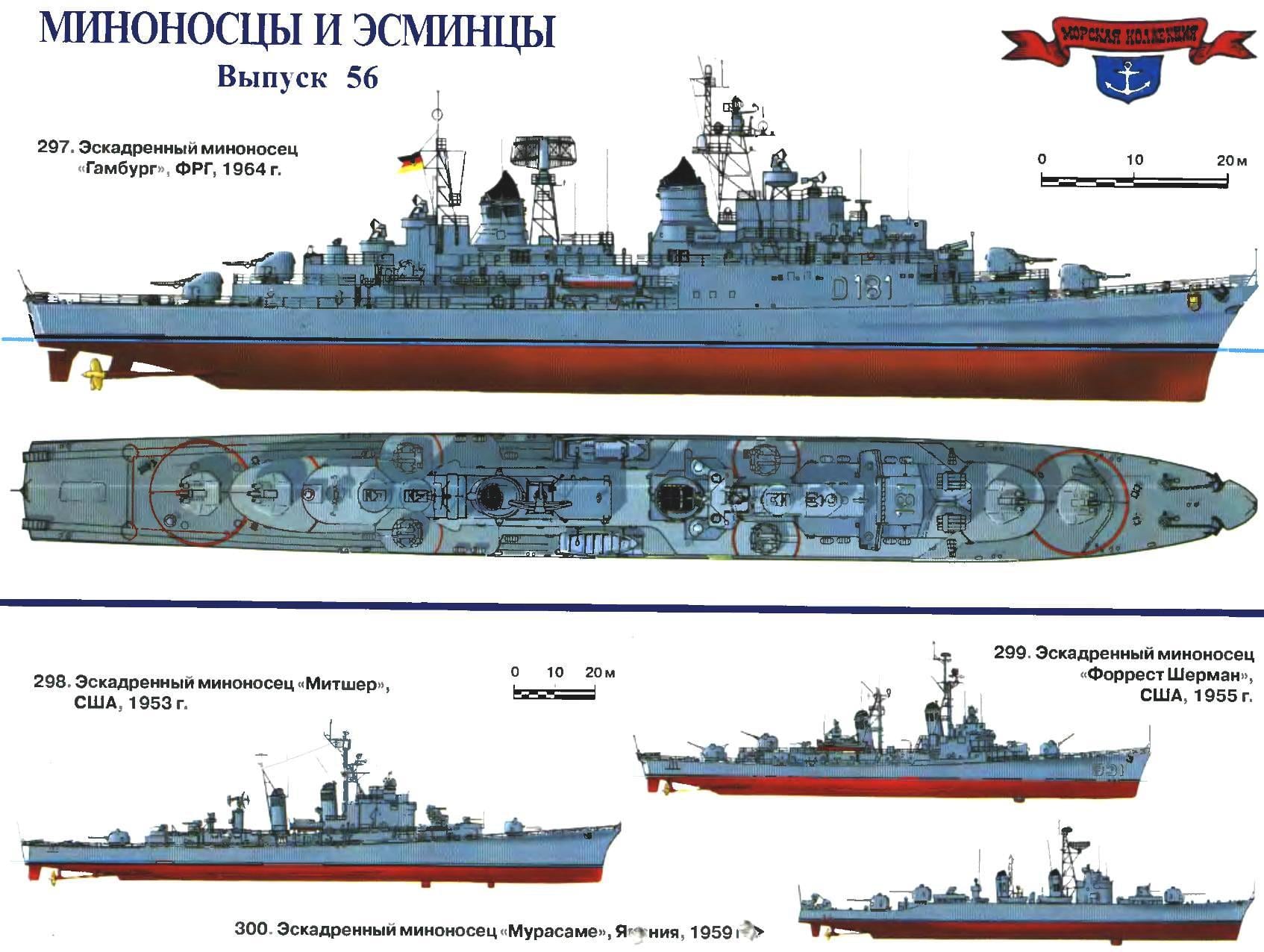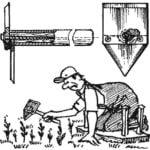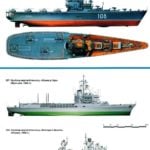 The lessons of the Second world war, naval warfare was not quite obvious and understood immediately. The first attempts of consideration of combat experience led to the emergence of the destroyers, though having excellent characteristics, but is quite traditional in concept (described in previous issue). A clearer awareness of their role took a lot of time, so shipbuilders in many countries have decided to pause or be limited to only experimental ships.
The lessons of the Second world war, naval warfare was not quite obvious and understood immediately. The first attempts of consideration of combat experience led to the emergence of the destroyers, though having excellent characteristics, but is quite traditional in concept (described in previous issue). A clearer awareness of their role took a lot of time, so shipbuilders in many countries have decided to pause or be limited to only experimental ships.
What is fundamentally new gave military experience based on the deaths of nearly thousands of destroyers and escort ships? It is understood that one of the most important factors was not quantitative composition artillery weapons, and its level of quality. Especially it is a fair situation for firing at air targets. Remember the Japanese ships, bristling with many tens of medium-caliber antiaircraft guns and machine guns. A barrage of indirect fire rarely helped them to avoid the hits of the American dive-bombers, and even less maneuverable torpedo. During the war anti-aircraft guns were mainly under the control of the commander’s own calculation and no centralized distribution of air targets between them did not exist. As a result, many planes during the attack in General was not under fire! In addition, affected a small initial velocity of the projectile (for example, the British “POM-POM”) and the lack of rate of fire (Soviet, French, Italian and German semi-automatic caliber guns, 37-45 mm). An acceptable alternative was to be on the ship let a small number, but very quick-firing guns with good ballistics, managed by the special system, preferably automated, capable of fire guidance radar. Of course, the more such plants would be able to place on the ship, the better, but naval theorists were well aware that the improvement of the technique is due to the huge increase in its mass. So all the destroyers, a new generation had fewer guns than their counterparts in wartime, but their firepower is not decreased, and the efficiency of the fire has increased significantly.
Another, seemingly paradoxical requirement time was cut in torpedo armament. From post-war destroyers had very little chance to use his once-great weapon against large surface ships of the enemy. Already during the war the “extra” torpedo tubes have often become a convenient object for replacement with additional anti-aircraft guns or anti-submarine weapons. Now this practice was finally legalized.
But the sharply increased demands on the part of anti-submarine weapons and equipment. Submarines have become the main enemies of all escort ships, primarily destroyers. Gone are the days when submarines could only be fought with “track” — release gear on the stern. On modern destroyers the destroyers began to appear more and more sophisticated means of dealing with an invisible enemy. The main requirements to the weapons of the PLO began its range, accuracy and mobility. And then again came to the fore torpedoes, anti-submarine homing only.
Another, perhaps the most important factor in determining the “form and content” destroyers of the second half of the XX century — the introduction of a great number of devices: detection and tracking of targets, weapons control, etc. Very quickly, the number of radars for different purposes reached a dozen, and combat information posts — a sort of “think tanks” — have become an integral part of the ship. To accommodate all of the innovations needed in the first place, the volume of which acquired not less critical than the mass in the early stages of the development of torpedo forces. Huge logging, add-ins and an abundance of antennas have changed the appearance of destroyers.
The common conclusions from wartime experience concrete steps for their implementation in different countries were not identical. The Americans were in the best position. They had a huge fleet of very modern type destroyers “Fletcher”, “Geared” and “A. Sumner,” has not yet exhausted its technical and innovative resource. A huge number of VMS guaranteed the United States the lack of real competition on the seas for at least a decade. Therefore, experts was able to slowly create prototypes of future warships, including destroyers.
The changed situation in the world completely turned upside down requirements for the composition of the fleet in General and to the technical characteristics of military ships in particular. The only serious potential enemy was the Soviet Union — even regardless of the rapidly deteriorating international situation, but simply for lack of other competitors. However, the Soviet Union was unlikely to threaten the Americans surface ships, at least until the completion of their programs, but the submarine forces of the Soviet Country were terrifying. Especially dangerous Americans seemed to be under construction taking into account the German experience of the boat with a high speed of surface and underwater speed. Therefore, the first post-war destroyers of the type “A. mitscher” had a pronounced anti-quality. Conceived in 1944, it was intended to carry restoratio battery of 127 mm semi-automatic guns with a barrel length of 54-caliber and high-velocity projectiles. However, by the time of insertion already tested the new automatic weapon with the same ballistic characteristics, but produced 45 shots per minute instead of 20. “A. mitscher” received only a few such units, but the firepower he surpassed their famous predecessors of the type “A. Sumner” and “Gearing”. And that’s not counting the four 76-mm guns, producing four to five shells per second! By the way, many experts have preferred to generally be limited to only 76-millimetrovie. I had to resort to inviolable authority of the winner of the war in the Pacific Admiral Nimitz, rightly believes that a destroyer, even a new concept, could use a more solid tool.
Although “mitsero” survived torpedo tubes, they were intended now only for launching self-homing anti-submarine torpedoes, who in accordance with the statement of doctrine of the U.S. Navy’s primary means of combat submarines of the potential enemy. However, a far more impressive look two impressive setup, who held on the deck of a great firing position and resembling a short-barreled large-caliber guns. This automatic reactive anti-submarine mortars, the designation of “weapon” (“Weapon A”). The original idea of American engineers was a neat device in an enclosed turret, which had a circular firing and is able to produce a dozen depth charges in less than a minute in any sector. Sailors often called these mortars by the nicknames “alpha” or able (“Able”).

297. Destroyer Hamburg, Germany, 1964
Built by “Stalken”. Displacement standard, t 3340, 4330 full t Length overall 133,7 m, width of 13.4 mg draught of 5.2 m. the thickness dvuhsvetnoe steam turbine 72 000 HP, speed 36 knots. Armament: four 100-mm universal automatic guns, eight 40-mm guns, two 375-mm RBU, five 533-mm torpedo tubes. Just 1964-1968 years built four units: “Hamburg”, “Schleswig-Holstein”, “Bay-ERN” and “Hesse”. Written off in the years 1990-1994.
298. Destroyer “A. mitscher”, USA, 1953
It was built by the firm “bath Iron Works”. The standard displacement of 3650 t, t 4855 full Length the greatest 149,4 m, width 14.5 m, draft 4,5 m. Capacity twin-shaft turbine plant 80 000 HP, speed 36.5 per node. Armament: two 127-mm and four
75-mm universal automatic guns, two RBU “Upon A”, four 533-mm torpedo tubes. Just 1953-1954 built four units: “A. mitscher”, “John McCain”, “Willis Lee” and “Wilkinson”. All written off in the years 1972-1978.
299. Destroyer “Forrest Sherman”, USA, 1955
It was built by the firm “bath Iron Works”. Displacement standard, t 2740, t 4020 full Length the greatest to 127.6 m, width of 13.7 m, draft 4,6 m. Capacity twin-shaft turbine plant 70 000 HP, speed 33 knots. Armament: three 127-mm and four 76-mm universal automatic guns, two RBU “Hedgehog”, four 533-mm and six 320-mm torpedo tubes. Only in 1955— 1959 built 18 units. Written off in the years 1982-1994.
300. Eskadrennyj destroyer “Murasame”, Japan, 1959
It was built by the firm “Mitsubishi”. The standard displacement 1840 tonnes, full 2600 T. maximum Length is 110.1 m, width 11.0 m, draught 3,7 m Power dvuhsvetnoe steam turbine 35 000 HP, speed 32 knots. Armament: three 127-mm semi-automatic and four 76-mm universal automatic guns, one RBU “Hedgehog”, two torpedoes canceller PLO. Only built in 1959 three units: “Murasame”, “Udate and Harusame”. Converted in auxiliary ships in 1984-1985, excluded from the lists in 1987-1989.
Interesting technical solutions were, however, spoiled by not one fly in the ointment. Long 70-caliber 76-millimeter guns could not be delivered in time and had to be replaced by a less rapid-fire 50-caliber with a worse ballistic performance. “Upon eybl” was capricious and did not meet expectations. But, more importantly, the ships came too expensive and limited series of only four units. Among the hundreds of standard destroyers wartime it was a drop in the sea.
Attempt to reduce the cost led to the emergence of the “mobilization” option “Mitcher”. That was what was originally planned “Forrest Sherman”. However, studies have shown that it is easier and cheaper to completely redo the project. So there was the last American destroyer of the classical type. The arms were reinforced with one 127-mm gun mounted in the stern, where it could shoot even with a relatively big swell. Bulky and unreliable mortars “eybl” gave way to “hedgehog” — a single at the time tested combat experience, rocket-propelled mortars, although it was noticeably outdated. Anti-submarine torpedoes originally was dumped into the water from special holders, but then they designed a light 320-mm torpedo tubes. Well equipped with the most modern at the time technique, “Sherman” do steel ships of another generation. One of them served as officers recalls a miracle that he could even at night with one click send located in 20 kilometers of the goal one hundred and fifty 127-mm shells per minute. All this became possible only thanks to new radar and automation.
With regard to naval architecture, and here, finally formed the approach laid down at the end of world war II: a flush-deck hull without Windows with raised stem, allowing to maintain high speed and combat capability, even in a storm. Undoubtedly, the production of “Sherman” would continue for years, if not a new era — the development of missile weapons soon brought the destroyers completely new requirements.
And what about the former adversaries of the United States? The once formidable Japan officially announced the creation of the only “self-defense forces”, which, however, gradually unfolded, though in a small but real the army and Navy. However, now under the close tutelage of a senior partner in the United States. The ships own post-war construction have become the destroyers”, Harukaze and Yukikaze”, which entered into operation in 1956 and was the “truncated” 1700-ton escort variant “Fletcher”. They left only three 127-mm guns (all the same, with the length of the barrel in 38 caliber), two of which were located in the stern, and eight 40-mm guns. But significantly increased anti-submarine weapons: now it included two “hedgehog”, eight conventional mortars and the release gear. Needless to say, all the electronics had also of American origin. Kinda “tactics” of the United States: on the one hand, they did not oppose the construction of warships to its former main rival, and with another — has supplied equipment that has made them notoriously uncompetitive .
The Japanese are outwardly dutifully followed the leader. A new series of six type destroyers “Ayanami” have an even more pronounced anti-submarine characteristics. For the same displacement and speed of 32 knots armament of the ships consisted of six 76-mm guns, four torpedo tubes and two kickers for anti-submarine torpedoes, as well as a pair of jet “hedgehogs” and two conventional mortars. These destroyers only by the fact that they again took the traditional hull shape with a pinched stem and cut aft, typical for most Japanese vehicles 30-40 years.
More “serious” were three units of the type “Murasame”, which had enhanced anti-aircraft artillery, for which overseas “uncle” has not regretted a relatively decent 127-mm guns with a barrel length of 51 caliber shot by the time with carriers such as the USS midway. Again, the SDF got the ships, like the number of guns and mortars the same “mitsitam”, but in fact inferior to them in all the combat options at least twice. The last of the “plagiaristic” destroyers “of Akizuki” and “Terusuke” — was put into operation in 1960. They differed from its predecessors significantly increased displacement (standard 2400 tons) and more powerful anti-submarine armament, which included additional “Upon Abel” (note, also already coming down with arms to the States themselves). The artillery remained in the same composition. Larger case later turned out to be a good platform for a more modern weapon: the failed “eybl” removed, replacing it in 1977-1978 375-mm rocket mortar “Bofors”, and adding six 320-mm anti-submarine torpedo tubes. Despite the low military quality, all of the first post-war destroyers of the rising sun safely served for three decades.
Another former enemy of the Americans — Germany — before joining NATO was satisfied with the few old battle ships from the number “granted” by the allies. In August 1957 the command Bundesmarine presented the program of development of the Navy, which included a series of 12 destroyers type 101. Again, as in 30-e years, the Germans did not think to reckon with Treaty limitations on tonnage, amounting to 2500 now so Called “linkorama” names in the German lands and the city-state of Hamburg, the 101 series has risen from a third. Had to retroactively raise the limit to 6000 so However actually begun operation, only four of these strange ships, clearly nedovarennye for its size. However, of all the destroyers of the defeated countries they were most likely to meet the new post-war requirements and, unlike the Japanese, had if not exclusively domestic, though of European weapons and equipment.
V. KOFMAN



